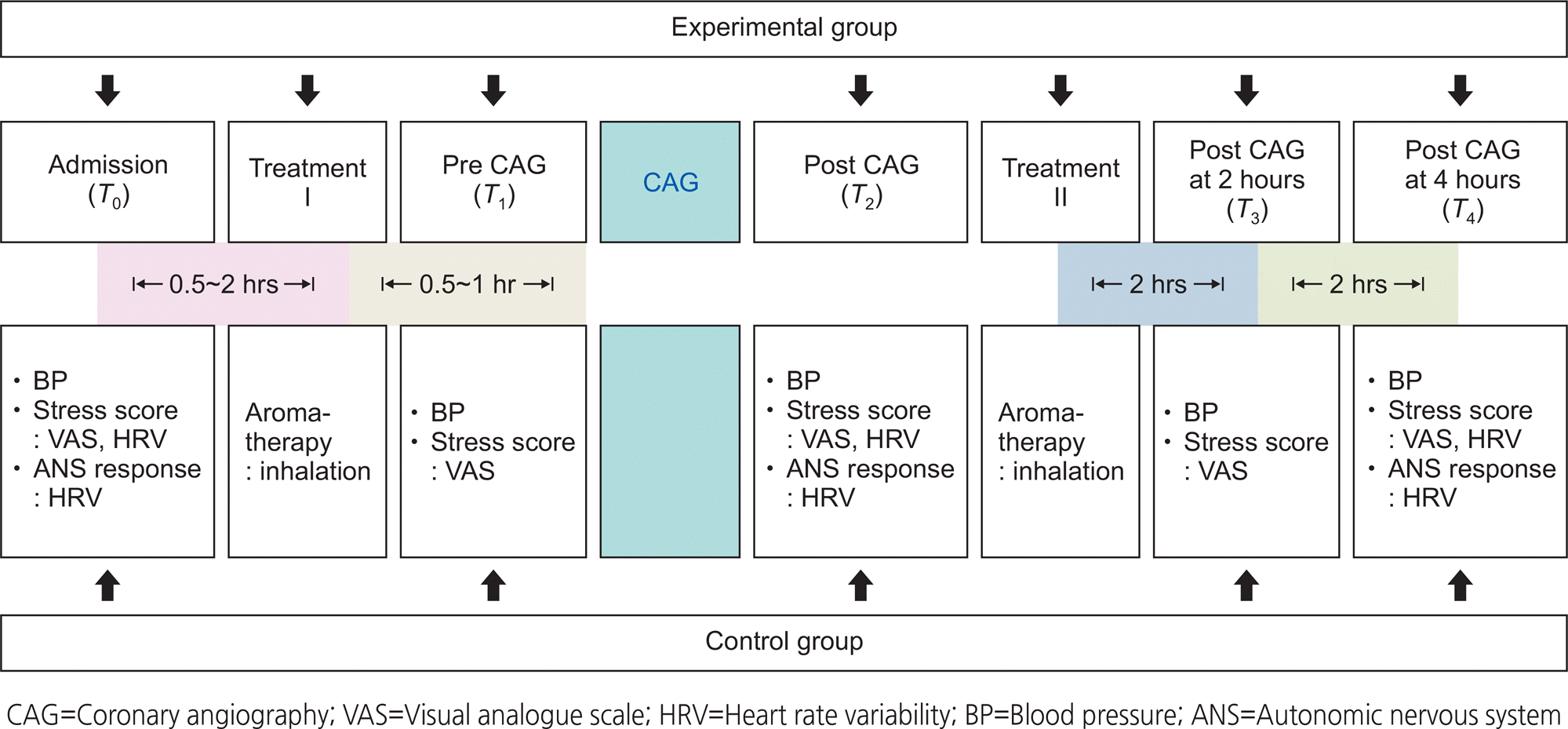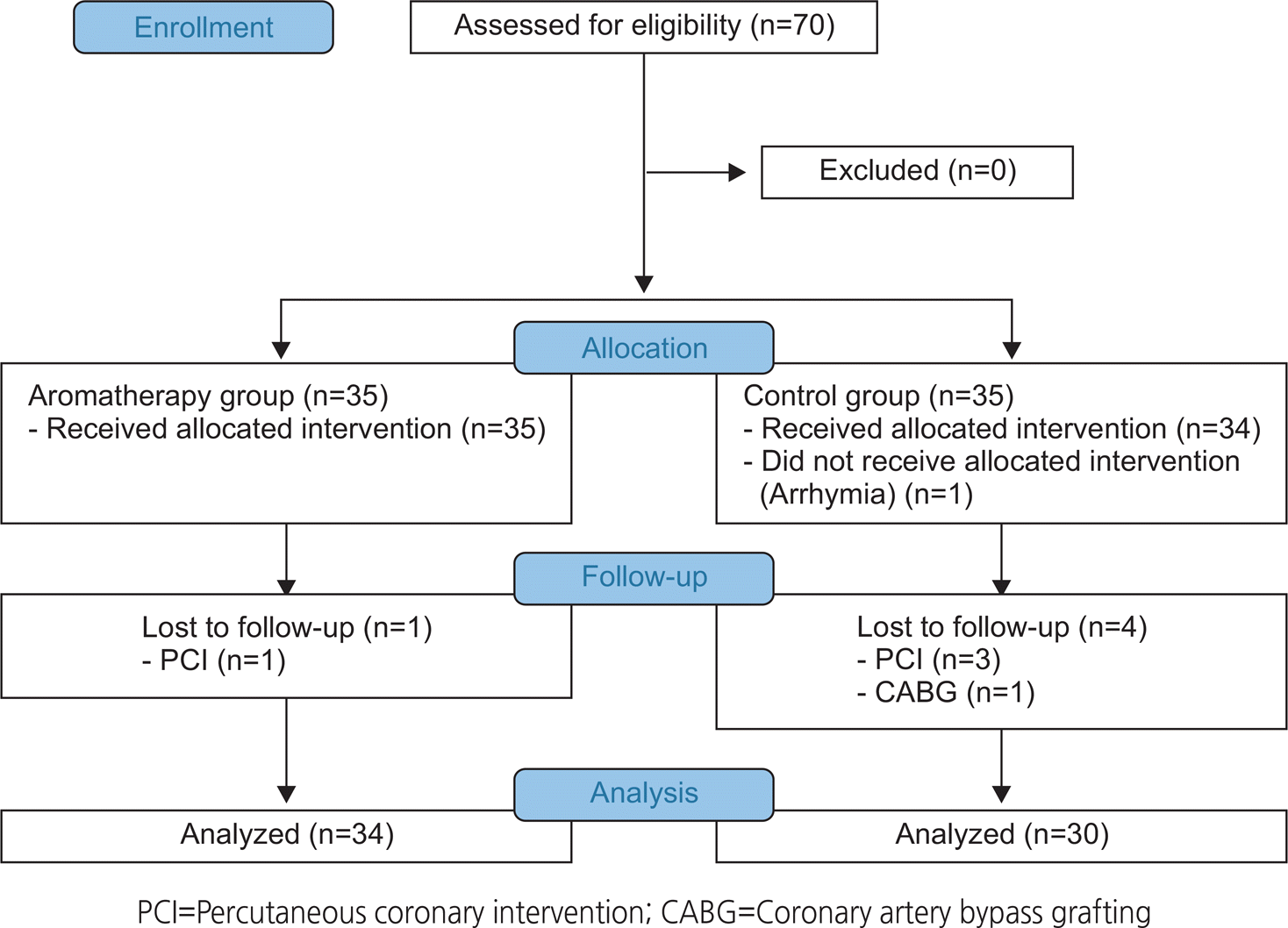Abstract
Purpose
The purpose of this study was to examine the effects of aromatherapy on stress responses, autonomic nervous system (ANS) activity, and blood pressure in patients hospitalized to receive coronary angiography (CAG).
Methods
A non-equivalent control group with a pretest-posttest design was used. The subjects were patients admitted to the day angiography room to receive CAG at E University Hospital (34 in the experimental group and 30 in the control group). The experimental group treatment was inhalation of the aroma oil blended with lavender, ylang-ylang, and neroli at a ratio of 4:2:1 twice before and after CAG. The measurements of stress index, ANS activity, and blood pressure were performed 5 times as follows: at admission, at pre-CAG after treatment I, at post-CAG, 2 hours after treatment II, and 4 hours after treatment II. The data were analyzed using the Mann-Whitney U Test and repeated-measures analysis of variance.
Results
Significant interactions in the high frequency of ANS (F=5.58, p=.005) were observed between group and time. Stress index (z=2.14, p=.016), systolic blood pressure (z=4.14, p<.005), and diastolic blood pressure (z=3.28, p=.001) were significantly different between the experimental and control groups after 4 hours of treatment II.
References
1. Statistics Korea. 2015 cause of death in Korea [Internet]. Daejeon: Statistics Korea;c2016. [cited 2016 Sep 27]. Available from:. http://kostat.go.kr/portal/korea/kor_nw/2/6/2/index.board?bmode=read&aSeq=356345.
2. Kasper DL, Braunwald E, Fauci AS, Hauser SL, Longo DL, Jameson JL. Harrison’s principles of internal medicine. 16th ed. New York: McGraw-Hill;2005. p. 1277–1278. 1410-1413.
3. Park AR, Choi JY. Factors predicting patient discomfort after coronary angiography. Journal of Korean Academy Nursing. 2009; 39(6):860–867. https://doi.org/10.4040/jkan.2009.39.6.860.

4. Ann SR, Suzanne MT, Paulena N. Family life management. 6th ed. New York: Macmillan;1986. p. 269–307.
5. Lee HS, Hwang HS, Kim YA. Effects of hand massage with aroma oil on stress responses and serum immunity of registered nurse during the night duty. Journal of Korean Academic Society of Nursing Education. 2007; 13(2):169–176.
6. Jamshidi N, Abbaszadeh A, Kalyani MN, Sharif F. Effectiveness of video information on coronary angiography patients’ outcomes. Collegian. 2013; 20(3):153–9. https://doi.org/10.1016/j.colegn.2012.06.001.

7. Kang MS, Park KM, Park CJ. Deducing coronary artery disease anxiety through musical therapy and providing information. Journal of Korean Academy of Nursing. 2000; 30(2):380–390. https://doi.org/10.4040/jkan.2000.30.2.380.

8. Lee HY, Kim SY. The trends of nursing research on aromatherapy in Korea. Journal of East-West Nursing Research. 2010; 16(2):85–95.
9. Homeyra T, Ghahraman M, Vahid M, Soghra H, Homeyra A, Niloofar R. The impact of aromatherapy on the anxiety of patients experiencing coronary angiography. Zahedan Journal of Research in Medical Sciences. 2012; 14(3):51–55.
10. Tahmasebi H, Abbasi E, Zafari M, Darvishi H. The impact of aromatherapy on hemodynamic condition of patients experiencing coronary angiography. Medical Surgical Nursing Journal. 2013; 2(1-2):26–32.
11. Karadag E, Samancioglu S, Ozden D, Bakir E. Effects of aromatherapy on sleep quality and anxiety of patients. Nursing in Critical Care. 2017; 22(2):105–112. https://doi.org/10.1111/nicc.12198.

12. Shiina Y, Funabashi N, Lee KH, Toyoda T, Sekine T, Honjo S, et al. Relaxation effects of lavender aromatherapy improve coronary flow velocity in healthy men evaluated by transthoracic Doppler echocardiography. International Journal of Cardiology. 2008; 129(2):193–197. https://doi.org/10.1016/j.ijcard.2007.06.064.
13. Nomura S, Maeyama K, Ito K. Enhancement of autonomic stress response and reduction of subjective stress by lavender inhalation during a short-term calculation task. Advanced Biomedical Engineering. 2016; 5:7–12. https://doi.org/10.14326/abe.5.7.

14. Salvatore B. The complete guide to aromatherapy. 2nd ed. Brisbane: International Centre of Holistic Aromatherapy;2003. p. 236–279. 409.
15. Mahmood RN, Javad B, Mahdi BM, Hossein A. Effect of aromatherapy on anxiety in patients with acute coronary syndrome hospitalized in cardiac care unit. Bali Medical Journal. 2017; 6(2):331–336. https://doi.org/10.15562/bmj.v6i2.385.
16. Choi JY, Oh HK, Chun KK, Lee JS, Park DK, Choi SD, et al. A study for antistress effects of two aromatic synergic blending oils. Annals of Clinical Neurophysiology. 2000; 2(2):70–80.
17. Cho MY, Min ES, Hur MH, Lee MS. Effects of aromatherapy on the anxiety, vital signs, and sleep quality of percutaneous coronary intervention patients in intensive care units. Evidence-Based Complementary and Alternative Medicine. 2013; 2013:381381. https://doi.org/10.1155/2013/381381.

18. Kim HY, Lee S. Effects of aromatherapy on anxiety and sleep of inpatients with coronary angiography. Journal of People Plants and Environment. 2014; 17(6):457–463.

19. Jennine S. The autonomic nervous system and aromatherapy: A therapist’s guide to working with the two systems. New Westminster: International Essential Oil Corporation;1998. p. 2–10.
20. Bae JM, Park GH. An illustrated guide to medical statistics using SPSS. Seoul: Hannarae Publishing Co.;2012. p. 1–367.
21. Lim SU, Park HJ. The effects of aroma inhalation therapy on stress, anxiety and depression in coronary care unit patients. Journal of Korea Contents Association. 2016; 16(3):1–10. https://doi.org/10.5392/JKCA.2016.16.03.001.

22. Muzzarelli L, Force M, Sebold M. Aromatherapy and reducing preprocedural anxiety: A controlled prospective study. Gastroenterology Nursing. 2006; 29(6):466–471.
23. Peng SM, Koo M, Yu ZR. Effects of music and essential oil inhalation on cardiac autonomic balance in healthy indi- viduals. Journal of Alternative & Complementary Medicine. 2009; 15(1):53–57. https://doi.org/10.1089/acm.2008.0243.
24. Bae IL, Hur MH. The effects of essential oil inhalation on the stress and sympathetic nerve activity. The Korean Journal of Stress Research. 2016; 24(2):75–83. https://doi.org/10.17547/kjsr.2016.24.2.75.

25. Shin YS, Cho YS, Jung YJ. The effects of aromatherapy on autonomic nerve system and physical resistance of a stress. Journal of Korean Biological Nursing Science. 2004; 6(2):5–17.
Table 1.
Homogeneity of General Characteristics and Dependent Variables between Groups (N=64)
Table 2.
Comparison of Stress, Nerve Activity, and Blood Pressure between Groups (N=64)
Exp.=Experimental group; Cont.=Control group; CAG=Coronary angiography; T0=Admission; T1=Pre CAG; T2=Post CAG; T3=2 hours after CAG; T4=4 hours after CAG; LF=Low frequency; HF=High frequency; SBP=Systolic blood pressure; DBP=Diastolic blood pressure; VAS=Visual analogue scale; M=Mean; SD=Standard deviation.
†Mann-Whitney U test; ††Friedman test.




 PDF
PDF ePub
ePub Citation
Citation Print
Print




 XML Download
XML Download